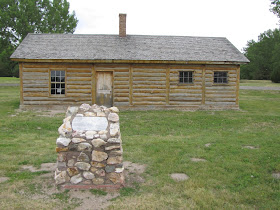When Sandy found this campground on the map she knew it was called a fort. It is that and much more. Fort Robinson was an active military post from 1874 to 1948. There is a lot of history here.
I got to thinking about how so much of the history of the western half of the U.S. is really not that old.
When this military outpost was founded in1874 the Union contained 37 states. Five years later Thomas Edison would invent the electric light bulb. In 11 years the first automobile would be developed by Benz. That doesn't detract from our history, it just illustrates that so many major events didn't take place that long ago. But back to Fort Robinson. It is huge and it is very pastoral. Lots of big trees. Lots of buildings and lots of well-tended grounds. It reminds me of a laid back and well-tended resort.
Fort Robinson was established as a post-Civil War Indian Agency protective post, but the interpretation of the word "protective" is certain open to interpretation. Especially since Chief Crazy Horse was murdered here.
Fort Robinson no longer belongs to the U.S. and that might explain why the State of Nebraska has done something really unique: it rents out many of the Enlisted Men and Officers' living quarters to tourists. We saw groups of friends or families spending time on large front porches or having dinner on a side porch. The former Enlisted Men Barracks has been turned into a lodge complete with cafe. Interestingly, no rooms on the fort grounds have television or phones -- so you can really get away from the rat race here.
The fort was in operation for 74 years and has a rich history spanning its establishment as an Indian Agency protective post to holding German POW's during WWII. When the U.S. Army Cavalry used horses the fort was a "remount" facility and had as many as 2,000 horses and hundreds of mules on the grounds. Dogs were also trained here for military use. Another interesting piece of Fort Robinson history is that Walter Reed served as post physician for a number of years.
This morning we went to the Post Headquarters built in 1905. The beautiful old two-story white sided structure is now a museum. It has been filled with many, many photos and artifacts to help tell the 74 year history of the fort.
We also viewed a few of the other buildings but we could not go inside today. Not all structures are open to visitors every day.
Cottonwood trees are ubiquitous here on the high plains and some of them are magnificent. These two flank the entrance to our campground. From their size I am positive that they were very small trees back in 1874. The building seen between the trees is the Veterinary Medicine Building. Inside is a unique equine operating table. Horses would be led next to a vertical wooden wall, strapped in place and then anesthetized. Once they were subdued, the wall would be cranked into a horizontal operating table. The building contained sleeping quarters for night attendants and a stable in back to hold up to 20 horses receiving treatment.
The historical marker below describes
the adobe officers' quarters (above).
I like the detail in the chimney's of the officers' quarters.
Not too shabby for government work in 1887.
As the responsibilities and the population at the fort
increased, more housing was needed.
Three of the original Officers' Row residences remain.
Sandy loved the detail of this early 20th century street light
along Officers' Row.
This is a replica of the original Guard House outside of which
Crazy Horse, Chief of the Ogallala Nation, was murdered
on 05 September 1877 while resisting arrest. To this day
their is a discrepancy about whether he was accidentally
stabbed by one of his tribe who was restraining him or if he
was stabbed by a soldier.
Tomorrow we head into South Dakota. Stay tuned.










Great post on Fort Robinson. I learned a lot. Watch out for those cottonwood trees, they can really mess up your air conditioner! :)
ReplyDeleteThanks, Judy. Cottonwood fluff can clog up AC units, but since I recently found out they are not that hard to clean out, I am not too concerned. It is the mud daubers in AC units that worry me.
ReplyDelete